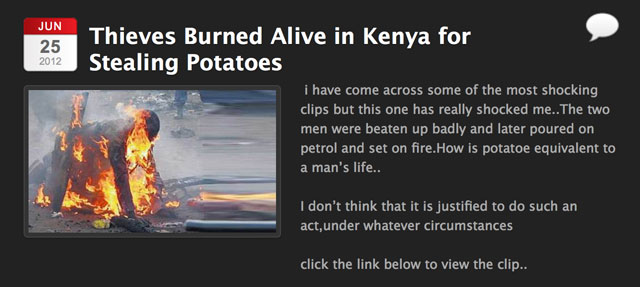Don’t fall for photo of man (repeatedly) burned alive
Colin Stewart is a 45-year journalism veteran living in Southern…
Until credible evidence emerges, it’s probably wise to set aside a widely shared story on Facebook that a man was burned to death in South Sudan because he was gay.

The article appeared on Hot in Juba, a website that describes itself as an “all round celebrity gossips and entertainment news website,” based in Juba, South Sudan’s capital. Coverage of that alleged incident has not been spotted on more traditional news websites in South Sudan, including those of the New Sudan Vision, New Nation, South Sudan Today and South Sudan Nation.
The photo that accompanied the story in definitely bogus. Probably it depicts an event that actually happened somewhere, perhaps in South Africa, but it definitely was not taken in South Sudan.
That same photo has been used to illustrate many articles painting a variety of people as villains, including homophobes, vigilantes, anti-government partisans, Muslims and outraged family members. The outrageous incident shown in the photo allegedly occurred in:

Northern Nigeria in 2011: “Women and children, burnt alive and impaled. Its muslim par-tay!”
Kenya in 2012: “Thieves Burned Alive in Kenya for Stealing Potatoes” with a link to a horrid video.

Pakistan in 2014: “Christian couple burned alive in Pakistan for allegedly desecrating Quran”
Burundi in May 2015: “Witnesses told BBC a man was even burned alive for supporting the government. “
Southern Nigeria in September 2015: “Thief Served Jungle Justice In Port Harcourt”
Ghana in September 2015: “An alleged robber has been killed and burnt to death by some residents of Kasoa [Ghana].” A separate article about that incident is more credible; it uses a different photo and includes comments from reporters on the scene.
Central Nigeria in October 2015: “25-Year Old Who Killed Man Who Stopped Him From Fighting His Sister, Burnt To Death By Mob”

In addition, although the Hot in Juba website couldn’t resist the temptation to publish the misleading photo, it was at least honest enough to label it with a disclaimer: “Photo Not Related.”



I saw this photo in connection with the xenophobic attacks in south afriva earlier this year but it had also appeared in connection with earlier attacks, I’ve seen a photo with a different angle where a police man is standing next to him with a fire extinguisher ready to put the flames out. It is a very disturbing photo and one can only guess the truth behind and the fate of the man….
after a quick google search I see the photo appear in a story about a man burnt in Pakistan for blasphemy. It’s a case of us readers being willing to believe in stories that confirm our beliefs (in this case anti islam). And in your stories case anti LGBT rights.
Quite so.
That said, it remains unclear whether the underlying story about South Sudan is valid or not. The use of a bogus photo, in this case a photo labeled “Not Related,” doesn’t mean that the story is untrue (or, of course, that it’s true).
FYI, I used the Google image search function to track down the many bogus uses of that photo that I cite in the article.
— Colin Stewart, editor/publisher of this blog
I find it is becoming more and more difficult to distinguish true articles from bogus ones, and it doesn’t help when the same photo is used in many articles. I found the same image on an anti muslim site saying muslims burning christians…
The difference is that Muslims like those in ISIS, HAVE burnt other Muslims, Christians, Jews, etc- just because the photo doesn’t match the story doesn’t mean it didn’t happen.
Just because the story is reported also doesn’t mean it happened. The photo and the story are repeatedly used to tell a horror story about scary strangers — both in Muslim areas and in Christian areas.
Let’s base our thoughts and deeds more on facts and on love. Let’s base them less on fear and hatred.
— Colin Stewart, editor/publisher of this blog.
Its a photo from the xenophobic attacks here in SA a few years back.